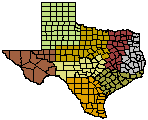- Trans Pecos
- High Plains/Panhandle
- Cross Timbers
- Hill Country
- Post Oak Savannah
- Pineywoods
- Oak Prairie
- South Texas Plains

Wildlife Division District Map
Panhandle Wildlife Management
White-tailed Deer, Mule Deer and Pronghorn
White-tailed Deer
The earliest sightings of white-tailed deer (Odocoileus virginianus) in the Texas Panhandle were made in 1854 by Marcy in Palo Duro Canyon. Preferred habitat for white-tailed deer at that time was probably limited to scattered riparian drainages in the Northern Rolling Plains of the central and eastern Panhandle that contained cottonwood, mesquite, juniper, skunkbush and other specie of brushy plants. Since these early reports brushy cover preferred by white-tailed deer has expanded in the Rolling Plains and the distribution of the white-tailed deer has done likewise. Implementation of the Conservation Reserve Programs on the High Plains also has provided tall grassy cover in some areas that encouraged white-tailed deer movements. Distribution of white-tailed deer in the Texas Panhandle is mainly in the eastern counties with a few populations in the northern counties
Additionally, expansion of the range of white-tail deer in Texas has been accelerated by trap and transplant operations conducted by Texas Parks and Wildlife (TPW) (1939 -1991) and private landowners (1950's - 1999). Most white-tailed deer were trapped in central and south Texas and subsequently released in Andrews, Armstrong, Borden, Collingworth, Crosby, Dallam, Dawson, Dickens, Fisher, Floyd, Garza, Gray, Hall, Hansford, Hardeman, Hartley, Haskell, Kent, King, Marten, Motley, Oldham, Potter, Randall, Scurry, and Stonewall counties.
Mule Deer
Historically mule deer (Odocoileus hemionus) probably occurred throughout most of the Texas Panhandle. The current Panhandle population may represent a mixture of the desert subspecies (O. h. crooki) and the Rocky Mountain subspecies (O. h. hemionus). Dallam, Sherman, Hansford and Ochiltree, Lipscomb counties lie within the historic range of the Rocky Mountain subspecies, whereas the remainder of Panhandle is considered historic range for the desert subspecies. As a result, desert mule deer from the Trans-Pecos region of Texas were used to re-stock several sites in the Panhandle. The first relocation of desert mule deer by the Texas Game, Fish and Oyster Commission (TGF&O) occurred in 1949 when 89 deer were released in Randall and Armstrong counties. Subsequent releases of mule deer (n = 646) were conducted between 1950 and 1988 in Garza, Kent, Oldham, Ochiltree, Roberts, Floyd, Motley, Briscoe and Cottle counties. Rocky Mountain mule deer from Colorado were released by the Oklahoma Department of Wildlife Conservation in southwestern Oklahoma and may have expanded there range into the eastern Texas Panhandle. Additional mule deer herds have subsequently developed in Andrews, Bailey, Cochran, Gaines, Hockley, Lamb, Terry, and Yoakum counties as a result of emigration form eastern New Mexico. Distribution of mule deer is generally across much of the Texas Panhandle.
Pronghorn
The pronghorn (Antilocapra americana) is endemic only to North America and represents the sole surviving member of the Family Antilocapridae, which included at least 13 genera in the Pliocene and Pleistocene. Fossil pronghorn data dates back to the Miocene (> 20 million yrs. ago!). Its scientific name means "American antelope goat." It is also called the prongbuck, pronghorned antelope, antelope, and American antelope. Pronghorn are the only mammals in the world with branched horns (not antlers) that are shed as if they were antlers. Pronghorn, like sheep and goats, have a gall bladder, but like giraffe, they lack dewclaws. Pronghorn are the fastest terrestrial animal in the western hemisphere, running in 20-ft bounds at > 60 mph, and sustaining high-speed runs for hours. The taxonomic position of the pronghorn is debated. Its placement in the Family Antilocapridae is based upon characters that set it apart from cattle and African antelope (Family Bovidae), such as annual shedding of its horn sheaths. Some argue that distinctions based on sheath-shedding are invalid and that Antilocapra belongs in a subfamily within the Family Bovidae (cattle and African antelope) because there is at least one species within each of the subfamilies of Bovidae that sheds the outer sheath of its horns. However, the way in which Antilocapra sheds its horn sheaths is very different from bovids. Bovids shed their sheaths in fragments, whereas pronghorn sheaths are shed whole. In Texas, pronghorn were historically distributed over the western two-thirds of the state, as far east as Robertson County in the north and Kenedy County in the south; however, today herds are restricted in their distribution to small fragmented populations extending from the Texas Panhandle to the Trans-Pecos region.
Locate a Wildlife Biologist
For further information locate and connect a Wildlife Biologist in your county.